Abstract
THE significance of the positive ion sheath, formed in the immediate vicinity of the wire in a Geiger – Müller counter during a discharge, has been discussed by the Montgomeries1 and by Stever2. According to them, the positive ion sheath is directly responsible for the dead time occurring in the counter after each discharge; the dead time is identified with the time necessary for the sheath to move sufficiently far from the wire for the field to be restored to a value at which the next event can be detected. Following this, Simpson3 and Hodson4 investigated the possibility of reducing the dead time by bringing the ion sheath back to the central wire and collecting it there. For this purpose they employed circuits by means of which the wire potential could be switched about 100 volts negative with respect to the cathode for a few microseconds after each discharge. Dead times as low as 20–30 microsec. were obtained in this way.
This is a preview of subscription content, access via your institution
Access options
Subscribe to this journal
Receive 51 print issues and online access
$199.00 per year
only $3.90 per issue
Buy this article
- Purchase on Springer Link
- Instant access to full article PDF
Prices may be subject to local taxes which are calculated during checkout
Similar content being viewed by others
References
Montgomery, C. G., and Montgomery, D. D., Phys. Rev., 57, 1030 (1940).
Stever, H. G., Phys. Rev., 61, 38 (1942).
Simpson, J. A., Phys. Rev., 66, 39 (1944).
Hodson, A. L., J. Sci. Instr., 25, 11 (1948).
Wantuch, E., Phys. Rev., 71, 646 (1947).
Hill, J. M., and Dunsworth, J. V., Nature, 158, 833 (1946).
Craggs, J. D. (private communication).
Penning, F. M., K. Acad. Amst. Proc., 33, 841 (1930).
Author information
Authors and Affiliations
Rights and permissions
About this article
Cite this article
COLLINGE, B. Reduction of Dead Times in Geiger–Müller Counters. Nature 162, 853–854 (1948). https://doi.org/10.1038/162853b0
Issue Date:
DOI: https://doi.org/10.1038/162853b0
Comments
By submitting a comment you agree to abide by our Terms and Community Guidelines. If you find something abusive or that does not comply with our terms or guidelines please flag it as inappropriate.



